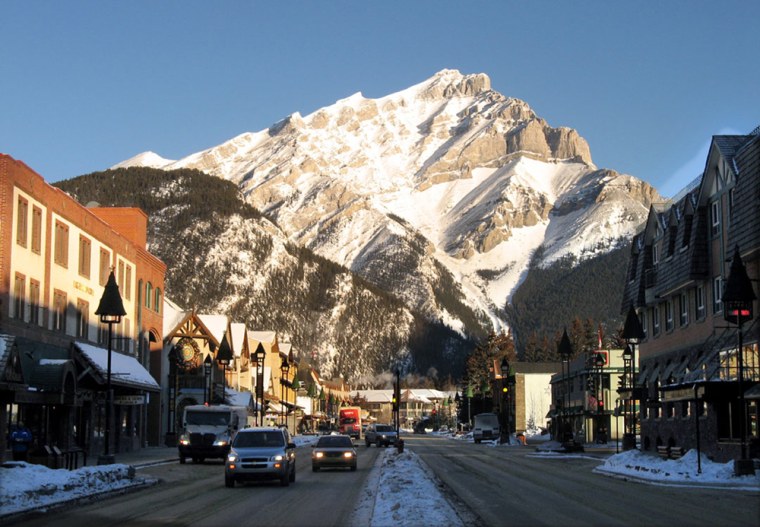In these days of green this and green that, many snowy-white winter resorts are suddenly touting their bright-green ecological purity. Few can touch the bragging rights of the three ski and snowboard resorts of the Banff region in Canada's Rocky Mountains. Set into Canada's first national park, the resorts occupy a zone that has been created to protect the natural habitat while allowing humans to enjoy it.
The resorts are not as familiar to U.S. skiers as other Canadian resorts like Whistler Blackcomb, in British Columbia, and Mont Tremblant, in Quebec. That's too bad, because these are great ski areas — and not just because they are environmentally responsible. Sunshine Village, which sits astride the Continental Divide, has trails tracing eastward into Alberta and westward into British Columbia. The lifts at Lake Louise Ski Area cross a rugged ridge to open hundreds of miles of trails and ungroomed skiing in a hidden valley. Norquay, the smallest of the three resorts and the closest to Banff, offers a full day of snow sports only a few minutes from the town's shopping and nightlife.
Together, these three resorts' lift systems service more than 7,000 acres of skiing and riding. The resorts offer some of the toughest in-bounds terrain in North America, along with hundreds of miles of intermediate trails with phenomenal cruising runs. Inexperienced skiers and riders get their own tucked-away beginners areas, and looping cross-country trail systems wind across the forested valley floors.
An unpromising arrival
Most visitors to the Banff region arrive in Calgary, Alberta, the center of Canada's oil-sands industry and one of the top crude-oil production centers in the world. High-rise buildings — the Exxon Building, the BP Building, the Shell Oil Building and others — sprout starkly from the very flat plains, while the low city suburbs stretch out endlessly across a dull-brown winter landscape. It is an inauspicious start for those seeking natural beauty and planet-friendly recreation, but the 90-minute drive from Calgary to Banff leaves plenty of time to view the majestic snowcapped mountains rising dramatically on the western horizon.
And, sure enough, Banff National Park is breathtaking. Soaring craggy peaks, deep forests, sheer cliffs, hot springs, crawling glaciers and rushing rivers greet visitors at every bend of the road. The original hardy settlers, who arrived in the late 1800s to build the trans-Canada railroad, would still recognize much of the landscape. Indeed little has changed beyond the building of the highway, the small Town of Banff and the resorts themselves.
Today, it seems that not so much as a larch needle can be removed from the park without a sheaf of paperwork and a hard look from a park ranger. Locals may grumble about the restrictions, but they also realize that the protected environment is the key to keeping their small tourist economy humming.
The resorts also take their environmental mandate seriously. When the Lake Louise Ski Area built its new six-person gondola, it used progressive construction techniques, hand-digging in some spots to protect rare plants that had been identified before the start of the project. Grizzly bears were monitored to limit the disturbance of their habitat and, to compensate for the land that was developed during the project, an equal-sized parcel was returned to natural vegetation.
At Sunshine Village, a team of executives is dedicated to balancing the environmental impact and growth of the ski-area operations. Animal habitats are carefully mapped and protected. Every physical improvement comes with land reclamation. Spring seeding projects enhance the summer flora, and employees work together to limit the use of automobiles through carpooling and subsidized public transportation.
Green hotels and town efforts
Some of the first construction projects in the park were the two now-famous hotels, iconic buildings that first served the tourists arriving on the Canadian Pacific Railway. The most notable was the Banff Springs Hotel (today's Fairmont Banff Springs), which opened in 1888 and has been continuously upgraded and enlarged to the present day. The Victorian building rises as a massive castle at the confluence of the Bow and Spray Rivers, near the bubbling thermal springs.
On the other side of the park lies the Chateau Lake Louise, also a Fairmont property. The chateau has grown from its humble wooden beginnings as a railroad hostelry into a luxury hotel today. Set beside the picture-perfect Lake Louise, it is now the largest hotel property serving the Lake Louise Ski Area.
Recently, Fairmont Hotels and Resorts initiated a "Green Cuisine" program, and the two Banff hotels are leaders in these efforts. They commit to using, whenever possible, sustainable, locally sourced and organically grown products in their everyday food-service operations. Even the staff cafeteria at the Chateau Lake Louise creates eco-friendly menus following the locally-grown rule. The effort includes composting organic waste (leftovers), which is then converted into mulch for use by local farmers. It also includes the redistribution of untouched foods (from banquets and buffets) to local homeless shelters — a program initiated by the Fairmont Banff Springs — and the purchase of kitchen supplies in bulk (or in reusable packaging) to eliminate disposable waste.
The Town of Banff has extended its recycling efforts to local festivals and events in the park under the banner "Towards Zero Waste." Local wastewater treatment is state-of-the-art. Parks Canada implements a comprehensive wildlife management plan and maps moose and elk herds carefully. Among its initiatives is the construction of massive highway overpasses, designed to blend with the surrounding vegetation, that allow animals easy passage over fenced roads.
These kinds of environmental efforts, spearheaded by the largest stakeholders in the national park, are replicated by smaller restaurants, hotels and shopkeepers throughout the region. Combined with sensible development plans and a regional commitment to recycling, they make a visit to Banff National Park a beautiful and eco-friendly experience.
